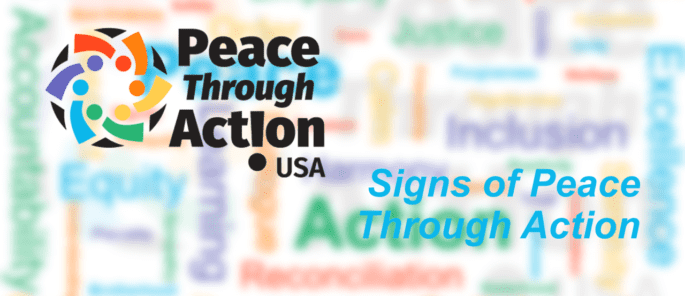
An Essay on being practically peaceful and #PeaceDayChallenge for #PeaceDay 2018
by Bob Reeg, Founder and CEO, Peace Through Action USA
There we were, 25 people gathered in a circle. Some who joined it were couples or friends, but the group overall was comprised of strangers.
One thing we had in common was a shared experience—having just seen the same theatrical play. To protect you from spoilers, I won’t reveal its name or plot other than to say that its teachable moments hinge on an act of violence. (If your curiosity overtakes my desire to protect you from spoilers click here to uncover the play.)
25 people, gathered in a circle, less estranged, more connected.
A second thing we shared was an apparent desire to learn. The theater company producing the rendition of the play we attended organizes community conversations to accompany some of the performances. Not everyone stayed after the performance, but 25 of us did.
25 people, gathered in a circle, less estranged, more connected.
The community conversation provided a space and time for group members to process the play. Our group observed through brief analysis of the plot that violence causes a ripple effect of adversities. First for its direct victims and perpetrators, then its witnesses, then the “near miss” people who “dodged the bullet” and feel grateful, yet guilty, then family members and friends. Let’s not forget the first responders, therapeutic helpers, court personnel, journalists covering the story, and eventually the community at large.
25 people, gathered in a circle, less estranged, more connected.
Several group members described their own encounters with the ripple effect of violence. One member recounted how his family’s “dynamic” shifted permanently after an uncle committed suicide at age 80, having served in World War II and never recovering from the trauma he experienced as a witness to the mass casualties that result from war. “We were never quite the same.” Or the member who described the time at his high school when one of their teachers was taken hostage at gunpoint and how that incident became part of the narrative of the school history ever since. “Everyone felt like this was their story, even though it was just one teacher and one student.” One glimmer of hope—a member recounted a period where a student serving as a stage manager for their extracurricular theater club took criticism of her “work performance” so deeply that she considered suicide to the point of having a plan; thankfully that stage manager stepped away from her personal brink after she received a thank you note for her contribution to the production from club leaders. Lesson: Gratitude matters.
25 people, gathered in a circle, less estranged, more connected.
Now, the program developer part of me saw opportunities for strengthening the community conversation. How about distribute a resource list to group members for our own follow-up? Perhaps the organizer could have collected our contact information to explore later whether and how the group could continue their conversation or attach the remnants of those of us interested in carrying on with the remnants of similar community conversations. Perhaps we could have enrolled on the spot to training of some type.
I mention these possibilities not to criticize the organizer, but rather to illustrate what becomes possible when more human help becomes available. Imagine what this one theater company could do if it had additional personnel to organize and deliver supplemental programming to its primary purpose—which is to produce plays. How many other theater companies could be offering similar supplemental programming were it not for the lack of people to plan and deliver it? And how many other settings and circumstances for increasing peace are missed each day because no such programming exists?
These are the daily questions of social purpose organizations: What should we be doing? What more could we be doing? And, how are we going to do it?
Peace Through Action USA strives to help answer those questions… by financing, mobilizing, and placing volunteers and year-of-service participants in helping roles with the groups that are already working to decrease aggression and violence in their communities, or that want to do so. We invite you, as a #PeaceDay gesture, to make a financial gift to Peace Through Action to help us help others.
More Americans, gathered in circles, less estranged, more connected.
There’s another part of our mission work. And that’s helping all of us defeat aggression and violence in the small ways each of us can—by being practically peaceful. Actions like taking a training on implicit bias or reducing racism and then applying the lessons. Or, learning and exercising bystander intervention techniques to equip yourself to get involved when you witness someone else being harassed or bullied. Or participating in a dialogue group on civility. The list of practical peaceful solutions is long. Here’s ours.
So, on this International Day of Peace, Peace Through Action USA challenges all Americans to commit now to do something to substantively and substantially increase peace where you live, learn, work, play, and pray. And invite others to join you in your action-taking. After all, #PeaceBeginsWithWe. And there’s no better day to start than #PeaceDay.
Countless Americans, gathered in circles, less estranged, more connected.

Respond